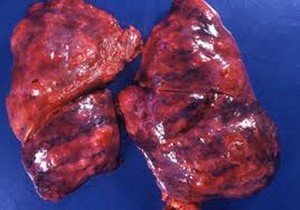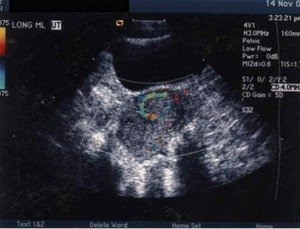What is Choriocarcinoma?
Choriocarcinoma is a malignancy of placental origin. It is an aggressive form of cancer originating from the trophoblast cells in the placenta. It has a fast spread to the lungs even early in the disease. Choriocarcinoma starts as a gestational trophoblastic disease and progresses to a malignancy. It is more common in women, but may also affect men. It is considered a germ cell tumor that develops from the ovaries and testes.
Choriocarcinoma In the Lungs as a Metastatic Disease
The malignant cells start in the syncytiotrophoblats and cytotrophoblasts that are responsible for the formation of the fetal structures and placenta. During embryonic development, there is no formation of placental villi. It occurs in the uterus and forms abnormal cells in the tissues that would normally form the placenta.
Choriocarcinoma is uncommon, but a highly curable malignancy associated in pregnancy. Because of the problems in the placenta, a fetus may or may not develop. It may also be called as trophoblastic tumor, chorioblastoma, chorioepithelioma or gestational trophoblastic neoplasia.
What Causes Choriocarcinoma?
The development of choriocarcinoma is preceded by other pregnancy related conditions such as hydatidiform mole, which constitutes 50% of all cases. Spontaneous abortion and ectopic pregnancy also results to 20% and 2% of the cases respectively. Normal term pregnancy may also result to 20 to 30% of choriocarcinoma. The malignant cells usually grow following a normal pregnancy. Genital tumors may also lead to choriocarcinoma. Hydatidifporm mole, the leading cause of choriocarcinoma is the development of grape-like structure that should have normally formed the embryo. The grape-like structures grow and should be removed because it does not cause viable pregnancy and may form malignant cells.
It in tetsicles is a rare form of choriocarcinoma. This form is the most aggressive germ cell tumor in adults. With choriocarcinoma in the testicles, there is a very aggressive hematogenous and lymphatic metastasis. Testicular choriocarcinoma is not responsive to anticancer drugs and has a poor prognosis.
What Symptoms Present in Choriocarcinoma?
Manifestations of choriocarcinoma include:
- Increased HCG (human chorionic gonadotropin) levels beyond the first trimester and excessively increased HGH during early pregnancy
- Vaginal bleeding, characterized as heavy and uncontrolled for some patients
- Swelling or edema of the uterus
- Presence of ovarian cysts
- Hypogastric pain
- Shortness of breath because of lung affectation
- Chest pain
- Hemoptysis
- Multiple infiltrates in the lungs seen in X-ray studies
- Increased thyroid stimulating hormone
- Men may experience hyperpigmentation, weight loss and gynecomastia
- Elevated beta HCG reacts with the TSH receptors and causes increased metabolic rate. This in turn mimics the effects of hyperthyroidism with weight loss as a symptom.
Staging of Choriocarcinoma
Staging of choriocarcinoma follows the FIGO staging system of uterine cancer. Different stages are described as:
- Stage I – Stage I choriocarcinoma involves the affectation of the uterus only. The malignant cells are limited inside the womb.
- Stage II – Stage II involves spread up to the genital tract only
- Stage III – Stage III choriocarcinoma involves the spread to the lungs. The metastases are hematogenous in nature, which means it has spread through the blood circulation.
- Stage IV – Stage IV involves metastases of cancer cells to other parts of the body through hematogenous and lymphatic routes.
How Choriocarcinoma Diagnosed?
Diagnostic tests are done to detect trophoblastic malignancy. These include:
- Pregnancy Test – The elevation of HCG in the blood and urine can be traced even when the patient is not truly pregnant. The HCG is the one detected in most pregnancy tests. A positive pregnancy test along with signs and symptoms may indicate choriocarcinoma.
- Pelvic Examination – Pelvic examination is also done to assess the uterus. Results may show swelling of the uterus along with tumor.
- Blood tests – Blood tests are done to determine the serum levels of HCG. A very high HCG level may be indicative of choriocarcinoma. Beta- HCG is specifically assessed because it is a tumor marker.
- Imaging Tests – Ultrasound, Computerized Tomography (CT) scan or Magnetic Resonance Imaging (MRI) scan identifies presence of tumor inside the uterus.
- X-rays – Chest X-rays are also done to determine lung metastases because choriocarcinoma is very aggressive in spreading to the lungs.
- Liver Function Test – Another organ that is initially affected by choriocarcinoma is the liver. Presence of high liver enzymes may indicate liver metastases.
How Choriocarcinoma Managed?
There are a lot of treatment modalities for choriocarcinoma, which include:
Chemotherapy
Choriocarcinoma is one of the tumors that are very responsive to chemotherapy, except for the case of choriocarcinoma in the testicles. The treatment rate is as high as 95%. Patients with no metastases have a high recovery rate. However, when metastases are already present in the brain and liver, the condition is usually fatal. The drug of choice for chemotherapy in low-risk disease is methotrexate. For intermediate and high-risk conditions, EMACO is employed, which consists of etoposide, methotrexate, actinomycin, cyclosporine and vincristine.
Surgery
The removal of the uterus or hysterectomy is usually employed for women aged 40 years and above. Patients with severe bleeding and severe infection are also required to undergo the procedure. Pregnant women with hydatidiform mole are required to undergo dilatation and curettage to remove the mole. Patients should be educated that the condition will not develop a baby. In this regard, counseling and emotional support is needed to allow the mother to grieve effectively with the loss of the pregnancy, which she assumed to be normal.
Radiation Therapy
Radiation therapy is also employed for choriocarcinoma that has metastasized to the other body organs.
Prognosis
Choriocarcinoma is highly treatable when metastases are not yet present. Women may also regain their optimal reproductive function. Poor prognosis of choriocarcinoma is associated with the following conditions:
- Presence of brain and liver metastases
- Reoccurrence of cancer, despite treatment in the past
- High HCG level reaching greater than 40,000 mIU per ml
- Occurrence of pregnancy symptoms of more than 4 months before therapy initiation
- Development of choriocarcinoma after delivery or normal pregnancy
Women may also have remissions, but may have more severe condition once the malignancy becomes active.
Complications
Complications of choriocarcinoma is primarily related to the complications of chemotherapy such as alopecia or hair loss, anorexia, muscle wasting, weight loss, nausea and vomiting and high risk for infection. Some choriocarcinoma may also reoccur after months up to 3 years of treatment.
Prevention
The primary prevention of choriocarcinoma is the early detection of hydatidiform mole to employ early removal and management of the condition. Improving the nutrition is also essential because most cases of hydatidiform mole are present among women with poor nutritional status.
Similar Posts:
- Partial Molar Pregnancy – Pictures, Symptoms, Treatment
- Fibroid Tumor
- Fallopian Tube Cancer – Symptoms, Prognosis, Survival Rate, Treatment
- Vaginal Cancer – Symptoms, Signs, Pictures, Treatment, Causes
- Stage 4 Liver Cancer (End Stage) – Life Expectancy, Survival Rate
- Urethral Cancer
- Ocular Melanoma









Leave a Reply